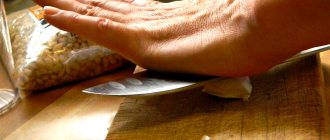Bivalve mollusks, mussels, are an exquisite delicacy, an essential component of most healthy lifestyle diets.
On Russian shelves you can find chilled fresh edible shell rock, frozen in shells and without shells, and pre-prepared preservation. Most commercial conditions of this seafood do not require cleaning, but there are positions that require simple preparatory procedures. Adding mussels to your diet?
- Yes 85%, 454 votes
454 votes 85%454 votes - 85% of all votes
- No 15%, 79 votes
79 votes 15%
79 votes - 15% of all votes
Total votes: 533
09.10.2019
- Yes 85%, 454 votes
454 votes 85%454 votes - 85% of all votes
- No 15%, 79 votes
79 votes 15%
79 votes - 15% of all votes
Total votes: 533
09.10.2019
×
You or from your IP have already voted.
How to properly clean mussels before cooking is a pressing problem: technological errors or the slightest negligence will ruin the gastronomic holiday (deteriorate the taste and aroma), and deprive the pleasure of the meal. Let's look at the problem in more detail.
With sink
On the shelves you can more often find shellfish with shells, which must first be cleaned, opened and cooked. Shells can be successfully prepared at home:
- If you purchased “pebbles,” you first need to remove algae, sand, and growths. Just wash thoroughly. To speed up the process, you can add corn flour to the water;
- Pour in and leave to settle so that the solids settle to the bottom. After half an hour, carefully remove the shells, without shaking the liquid or raising the turbidity, and brush the outside with a stiff brush. The shells should not float;
- Remove the byssus (this is the place where the shell attaches to the seabed). You can work with your hands or special tweezers;
- Finally
, rinse thoroughly; you don’t have to cut it up and cook right away. Removing the shell can be difficult.
Why does fish smell like mud?
Only river or lake fish can smell like “swamp”. This is due to the fact that there is a lot of vegetation in such reservoirs. In the heat of summer, the water begins to bloom, which is why all its inhabitants, after being caught, have a distinct, characteristic and rather persistent odor. If special measures are not taken, it will affect the taste.
diz-kitchen. ru
Most often, fish with the smell of mud are caught from small bodies of water with stagnant water, in polluted places with a lack of oxygen. Such ponds are often filled with fallen leaves.
Sea fish do not smell like mud. There is much more water in the sea; it contains many dissolved salts that prevent the appearance of mud.
Don’t be so quick to be disappointed and give up freshwater fish in favor of sea fish. High-quality river fish exists. The main thing is to find one for sale that was grown in a clean pond. Unfortunately, quality products are not always available for sale, so absolutely any freshwater fish can taste like mud: trout, crucian carp, carp, carp and catfish.
ns2.mobile-arsenal. com. ua
Frozen seafood processing
Frozen mussels, with or without shells, are sold in packages that are not opened first but left in the refrigerator until they are thawed. When the shellfish have melted, they are placed in cold water, completely covering the bag, and pressed down with a weight. You can use a glass jar filled with water for this. In this form, the shellfish will thaw much faster.
Thawed mussels are released from packaging. If they are without both doors or with one, then they must be immediately washed to remove sand under running water. Mussels in shells are placed in cold water for half an hour. When soaking, sand will settle to the bottom of the dish. Then the mollusks are pulled out with a slotted spoon, cleaned of dirt and algae, and antennae and threads are removed.
Read also: Men's clothing size charts
Raw thawed mussels without shells and with them are prepared in the same way: dipped in boiling water, stirred for 10 minutes, removed with a slotted spoon. If already cooked mussels without shells were purchased in the store, then after defrosting they are washed with running water and immediately immersed in boiling water.
1-2 minutes are enough to “refresh” the product - you cannot cook them longer, otherwise they will lose their delicate taste.
Selection of quality products
Mussels are bivalve mollusks that live in fresh waters. To prepare a delicious delicacy, the product must be of good quality and fresh. Therefore, it is necessary to consider tips on how to choose quality products:
- Frozen products should not have cracks or deformations. There should also be no frost visible. If such defects are present, we can conclude that the seafood product was previously defrosted. In such a situation, beneficial properties are lost.
- Cleaned frozen marine fauna should always be light in color.
Yandex pictures - To make the meat more juicy, nutritious and tasty, you need to choose large individuals. On packaging of well-known brands and quality products, two numbers are always indicated separated by a fraction. They indicate the quantity of mussels is 1 kg. The fewer pieces in the package, the larger the individuals will be.
- Shellfish are natural water filters in nature. Marine representatives can filter up to 7 liters per day. If they are grown in dirty areas, they can accumulate large amounts of harmful substances. Therefore, it is necessary to buy products only from reliable suppliers. If mussels are bought by weight, you will need to request a quality certificate from the seller.
Yandex pictures
From 1 kg of unrefined product there are 100 g of purified product.
Mussels boiled in milk
An unusual but very tasty combination of sea flavor with the aroma of milk. How to cook frozen mussels in milk?
. Pour a little milk (a glass and a half) into the saucepan.
. When the milk starts to boil, add salt.
. Lower the mussels (300-400 grams is enough) and while stirring so that the milk does not boil away, boil the shellfish meat for no more than five minutes.
You can also cook shellfish in this way, increasing the cooking time by 5-7 minutes.
Beneficial features
The main positive qualities of mussels include the following:
- prevention of arthritis;
- shellfish meat strengthens the immune system;
- improves liver function;
- normalization of the gastrointestinal tract;
- affects visual acuity;
- strengthens nails, hair, teeth and bones;
- makes the skin cleaner and gives it a healthy appearance;
- speeds up metabolism, which is indispensable in the fight against excess weight.
However, like any other product, mussels also have a negative effect on the human body. If you consume shellfish in excess, there is a chance of becoming infected with saxitoxin.
How to properly clean mussels at home?
Mussels are deservedly considered one of the most delicious and nutritious delicacies; they are actively used in the cuisines of many countries around the world, even if they are not typical for a particular area. When starting to create culinary masterpieces, you need to understand how to clean mussels correctly, otherwise there is a risk of spoiling the taste and aroma of a delicious dish. The approach will depend on the type of nutritional component.
Fresh, frozen and prepared mussels are processed differently, each method has its own characteristics and nuances. Proper pre-processing will not only allow you to prepare a satisfying and nutritious meal, but will also guarantee that you get the maximum benefit from the unique chemical composition of the meat.
How to open mussels correctly
First, you need to carefully remove small shells, growths, and algae residues from the shells with a knife.
Then wash the sinks with a brush under a strong stream of water and keep them in cold water with added salt for a couple of hours.
Then take the sink in your hands and carefully insert a sharp, strong knife between the doors. Pressing the knife blade against the top flap will open the shell so you can separate the meat.
Can be opened by heating.
To do this, they are either suspended in a sieve over boiling water, or kept in an oven preheated to a temperature of 90 degrees until the shells open.
After separating from the shells, the meat is placed in cold water for 1 hour. Afterwards, take it out and dry it thoroughly with a paper napkin or towel.
If you buy fresh frozen mussel meat, you need to pay attention to whether it is white or pink.
You need to defrost it very slowly, best by putting it in the refrigerator overnight. This is done so that the mussel meat does not lose too much moisture.
After this, it must be used immediately - boiled, fried, steamed, stewed, baked.
If you bring in the mussels yourself and cook them on the shore, everything becomes simpler. The mussels are cleaned of all excess, the “beard” is removed, washed several times with sea water and fried over a fire. Any method of frying: using a metal sheet, throwing directly into the fire, etc.
At all times, mussels have had a reputation as a tasty, healthy and inexpensive seafood product compared to oysters.
At the same time, it should be remembered that mussels, by their feeding method, are filter feeders and can accumulate inside their shells a certain amount of microorganisms and poisons that are harmful to humans.
All mussels harvested for human consumption must immediately undergo proper heat treatment and be properly stored and transported.
What you need to know about the mussels you'll eat
The best mussels are the ones you pick yourself.
Usually “hunters” of mussels cut them from the stones with a knife and remove them with special tongs.
If you have experience and dexterity, they simply tear it off with your hands. Beginners can easily get hurt - mussel shells have quite sharp edges.
Mussels collected in the summer season are especially good.
In April-May they are not yet mature enough, so they do not have a special taste.
It is believed that the Tarantino mussel is best consumed in the months that do not have the letter “R” in the Italian name: January, May, June, July and August (gennaio, maggio, giugno, luglio, agosto).
The most suitable for culinary processing are mussels aged from one year, when the shell reaches two to three centimeters, to four years (the length of the shell increases to approximately 10 centimeters).
The age of a mussel can be calculated by the stripes on the surface of the shell. Each of them is equal to one year.
The ideal shell length of a commercially available Tarantian mussel is 6 cm.
In very large shells the muscle is hard and difficult to process, i.e. softens.
Therefore, if you buy freshly picked mussels at fish markets, you do not need to focus on the large size of the shells - this is not an indicator of the quality of the mussels.
But it’s worth paying attention to the smells emanating from mussels.
You can smell the shell without hesitation - if your nose smells something wrong, you should refuse the mussel, preferring another one that smells of the sea and freshness.
The shells of mussels should not have any perforations (traces of encroachment on them by sponges), chips or cracks.
Inedible:
1. mussels washed ashore by the waves (do not be tempted by an easy trophy);
2. sinks with slightly open doors:
3. mussels whose shells did not open after heat treatment.
How to clean mussels frozen in shells
In this case, the shellfish must be properly thawed. This can be done in ice water. The mussels need to be pressed down with something suitable to prevent the valves from opening. Add some cornmeal to the water. Exposure time in water is 1 hour. During this time, you can completely get rid of the sand frozen inside the mussels.
Finally, the mussel shells should be thoroughly cleaned with a brush.
Fully opened shells or specimens with chips should, as already mentioned, be thrown away.
Culinary specialists greatly value seafood such as mussels because, even with a minimum of effort, they can turn into a real culinary masterpiece. But only those who know how to clean mussels before processing can count on obtaining such a result. Despite the simplicity of this manipulation, it is accompanied by a number of nuances. These points may vary depending on the initial state of the component. Cleaning fresh and frozen mussels is carried out according to different scenarios.
Saving dinner: 4 tips to help remove the aroma of mud
Of course, it is rare for anyone to throw away a fish that smells like mud. Many people will simply cook it and hope that the unpleasant aroma will disappear. We hasten to assure you that it will persist and become more pronounced if no measures are taken.
i2.wp. com
First, gut the fish well, be sure to remove the gills from it and perform the following manipulations:
Sometimes the situation is such that there is no milk, lemon or wine in the kitchen. Then the spices that are in every home will help save the fish. Sliced and cleaned fish should be rubbed with a mixture of ground black pepper, kitchen salt and bay leaf. Of course, the use of these aromatic additives will affect subsequent preparation, so you will have to select the appropriate recipe.
Make sure to thoroughly clean the inside of the fish. If there is a dark film inside, it should be removed and then the carcass should be washed thoroughly.
images11.domashnyochag. ru
How to cook frozen mussels without shell
If you don’t want to bother with the romance of shells, you can buy already cleaned fresh mussels. How long to cook mussels without shell? After boiling, this will take no more than 7 minutes if the product is used unfrozen. Pre-defrosted mussel meat is cooked for no more than 5 minutes.
How to cook frozen mussels?
The traditional method of cooking in water is no different from the above. You need to bring a small amount of water to a boil and add the clams there. Use the meat for preparing main courses.
More interesting is the cooking method, in which mussels become a separate dish.
Step-by-step preparation
- Defrost the mussels, rinse them under cold water and cook in a small saucepan for about 15 minutes.
- We clean the onion from the husk and top layer.
- Cut it into thin half rings.
- Heat a frying pan, add a little vegetable oil and fry the onion half rings until golden brown.
- Pour the mussels into the pan, add spices and fry for five minutes.
- Place the dish on a plate and sprinkle with chopped dill.
You learned how to clean frozen mussels without the shell and how to cook them. It is best to use spicy tomato, garlic or sour cream as a sauce.
How to cook mussels in gadgets
In a steamer
over steam - 10 minutes, mussels cooked this way are the healthiest. In a slow cooker
or in an open
pressure cooker
- 5 minutes after the water boils.
in the microwave
, slightly defrosting - literally 2-3 minutes at full power without adding water.
— When cooking mussels, it is necessary to take into account that overcooked mussels
will become rubbery and tasteless. Therefore, mussels should not be cooked for too long.
— Calorie content
Interesting facts about mussels
They need an aquatic environment to live.
Not far from the coast, on breakwaters, stones, cliffs, and artificial underwater reefs, they form a powerful coastal belt.
They are firmly attached by byssal threads (this is the sponge or “beard” that we remove when processing mussels) to various substrates (solid bases).
Types of mussels:
Korean, edible, Mediterranean, Pacific, Gray.
All of them are excellent biofilters, feeding on the smallest plankton and bacteria, unicellular algae, and the remains of aquatic plants and animals.
During the day, one five- to six-centimeter individual passes through itself 70-80 liters of polluted water and returns it to the sea clean and clarified.
Mussels live in all seas of the world. Places where they are crowded together in entire colonies, often forming druses, are called mussel sea banks. Drusa - from him. Druse - “brush”; This is when mollusks occupy one base and grow together.
A sea bank is a part of the seabed where the depth is much shallower than in neighboring areas.
A mussel bank is a sea shallow where mussels settle in huge numbers. The population density of mollusks on the bank is several hundred individuals per 1 sq. meter.
Italy is washed by five seas - the Adriatic, Ionian, Mediterranean, Tyrrhenian and Ligurian. And everywhere in the shallow waters live all sorts of sea limpets, sea urchins, sea cucumbers and sea dates, small crabs, and oysters. And, of course, mussels, which are very revered on the Apennine Peninsula. Along with oysters, of course.
Here it must be said that mussels are incredibly prolific. A female edible sea mussel can spawn up to 10 million mature eggs in one spawning period.
Mussels become sexually mature at two to three years, live 8-10 years, and have two spawnings during the year. You can imagine how many shells the seabed is covered with!
There are also river, freshwater mussels that differ from sea mussels in the quality and amount of “garbage” that they carry on and in themselves.
Mussels are the oldest inhabitants of the Earth
In Crimea, archaeologists still find large piles of empty doors during excavations.
Based on these accumulations, even an entire period in the history of the peninsula was identified under the name “shell midden culture.”
Selection of mussels
Before cleaning and cooking mussels , they should be sorted. You will have to throw away shellfish with damaged or open shells. Specimens that are too heavy will not work either; most likely they have a lot of sand inside.
Small commercial shellfish are usually soaked in cool water. Large mussels grown in sea farms do not need to be soaked.
Frozen mussels, which are much more common in our stores, should not show signs of repeated defrosting and freezing. Usually these are cracks in ice and frost.
How to properly clean frozen mussels?
- For a delicious meal, store frozen mussels in the freezer until the date printed on the package. Before you cook them, the mussels need to be thawed. To do this faster, place frozen mussels in cold water and press down with a weight, which will prevent them from opening prematurely. Once defrosted, they need to be cooked quickly.
- Some people think that mussels do not need to be peeled, but this is not true. This is necessary due to the fact that mollusks pass through a lot of substances and sand that need to be removed. Before you start cleaning the mussels, you need to check if they have opened . If the shell of the mussels is open, it is better to throw them away.
- After careful selection, place the mussels in a pan of cold water for a full hour. Add cornmeal to the water. This way you can clean the mussels from sand that did not have time to come out, remaining there before freezing.
- Set the mussels with their antennae aside and then clean them. To do this, use your fingers or pliers to pull the antennae toward the base of the shell. They can then be thrown away as they are no longer needed. After this, clean the sink from any dirt and sand stuck to it. A stiff brush will help you with this.
- Once you have completely cleaned the clams, place them in hot water and cook them until they open completely at high temperature. Add white wine or a little fish stock to the water to help the mussels cook better. This process usually takes 10 minutes. Shake the pan slightly during this time so that the mussels heat evenly. Serve the mussels that have opened, and discard those that have not opened.
Sequencing
- First you need to sort out the mussels. Throw away those that open on their own, and place the remaining ones in a deep bowl of cold water. This is necessary in order to filter out the remaining sand.
- Then fill the mussels with clean water and place on maximum heat, covering the pan with a lid. There is no need to salt the water, since the water inside the mussels is already salty. When the water boils, the shells will begin to open on their own. You need to boil them for about 20 minutes, but no more, otherwise the meat will become tough and flavorless. By this time, the contents of the mussels should curl up and take on a shape that should resemble regular meat in density. If there is still mucus in the shells, then the mussels are not ready yet.
- Finally, open the shells and remove the meat, it will be done without much effort. Some shells may have a bunch of threads - this is a device for attaching to surfaces. They should be removed as they are inedible.
- The resulting meat does not need to be cleaned, since all the contents are absolutely edible. There are many ways to make it tasty and healthy. Treat yourself and your loved ones with this delicacy.
Mussels are not an ordinary product, so it’s worth paying attention to. This product requires special serving and its own cooking methods.
Mussels are tasty and nutritious shellfish, some of which are grown on the coasts of Italy. This product is usually classified as a very healthy, delicious and low-calorie delicacy. Thanks to their unique composition, mussels have a number of beneficial properties and quickly saturate our body. Despite such a low calorie content, shellfish contain a record amount of essential amino acids. Most gourmets value mussels not only for their composition and beneficial effects, but also for their exquisite and unusual taste.
In this article you will learn how to clean frozen mussels without a shell, how to cook them properly and what to serve them with. In addition, we will analyze the beneficial properties and composition of this mollusk.
Fresh mussels baked in shells
Compound:
- fresh mussels in shells – 1 kg;
- fresh tomatoes – 0.3 kg;
- stale bread – 40 g;
- olive oil – 20 ml;
- garlic – 2 cloves;
- parsley - 1 sprig;
- cloves – 1 pc.;
- salt, pepper - to taste;
- water – 0.5 l.
Cooking method:
- Pour water into the pan. Place the peeled and washed mussels in their shells into it.
- Place the pan over high heat. Wait for the shells to open. Remove the tops by removing the mussels from the pan and letting them cool slightly.
- Crush the garlic.
- Pour boiling water over the tomatoes and remove the skins. Grate the tomato pulp, chop with a blender or rub through a sieve. Mix with garlic.
- Grind salt, pepper and cloves in a mortar.
- Grate stale bread and add to tomato puree.
- Put the spicy mixture there.
- Add olive oil, stir.
- Place the mussels, shell side down, on a baking sheet lined with parchment. Place tomato mixture on top of each mussel.
- Preheat the oven to 180 degrees and place a baking sheet in it.
Recipes
Mussel meat with green peas and sauce
Cooking time: 50 min. 400 kcal per serving
For 4 servings:
12 mussels,- 300 g sweet green pea pods,
- 400 g green peas (without pods),
- 300 ml concentrated fish stock (prepare in advance)
- 200 ml cream,
- 20 ml dry vermouth,
- 2 tablespoons lemon juice,
- 3 tablespoons whipped cream,
- white pepper,
- 50 g butter,
- sea salt.
1. Place mussel meat in cold water for 1 hour. Trim the ends of the sweet green pea pods with scissors and blanch them in boiling salted water for 4 minutes, remove and rinse with cold water. Perform the same operation with green peas without pods.
2. Boil the fish broth, cream, vermouth and lemon juice in a saucepan over high heat to 2/3 of the original volume.
3. Add half the pods and grains of green peas to the boiled sauce, make a puree with a mixer and rub it through a hair sieve. Reheat. Stir in whipped cream and season with salt and white pepper.
4. Remove the mussel meat from the water and dry thoroughly. Fry in 30 g of butter for 5-8 minutes over medium heat. Salt and pepper.
5. Stew the remaining peas and pods in 20 g of butter and season with salt and pepper. Divide the pods in a star shape among 4 plates and top each with mussel meat. Sprinkle green peas on top and pour over the sauce.
More sauces for mussels
The usual sauce for mussels is a mixture of olive oil, lemon juice, garlic and herbs.
Or maybe try these?
Orange oil with basil
Peel 1 orange and divide into slices. Boil 60 ml of white wine and 20 ml of dry vermouth. Add 400 ml fish broth. Boil down to 1/3 of the previous volume. Add 200 g butter and melt it. Beat the sauce with a mixer. Season with lemon juice and sea salt. Grind 8 basil leaves, 10 pickled green peppercorns and add to the sauce along with orange slices.
Sorrel with cream
Separate the leaves of 50 g of sorrel, bring the stems to a boil, adding 150 ml of cream, fish broth, white wine and 20 ml of dry vermouth and boil to 1/2 the previous volume. Strain the broth and beat it with 1 tablespoon of sour cream and 30 g of cold butter. Season with sea salt, pepper and lemon juice and 1 pinch of sugar. Cut the sorrel leaves into thin strips and mix with the sauce along with 1-2 tablespoons of whipped cream.
More approaches to cooking mussels
1. Make salads with them. For example: chopped mussel pulp cooked according to all the rules is mixed with pieces of chicken. Fresh herbs are added (dill, basil, mint, oregano). Dressing: mix the juice of one lime with three teaspoons of liquid honey and 1 tablespoon of wine vinegar.
2. Cook soups. Fantasizing.
3. Bake pieces of mussel pulp for 5-10 minutes on the grill, wrapping them several pieces in foil in the form of a bag.
Place mussels on a layer of grated boiled carrots, sprinkle them with parsley, cover them with lightly blanched red pepper pods.
Drizzle with any suitable sauce and place a couple of thin slices of lime on top. After cooking, pour the contents of each bag into special saucepans and decorate to your taste.
4. Fry peeled shellfish in batter, especially beer batter. Crispy deliciousness!
5. Professional chef Konstantin Brook talks very interestingly and clearly about how to cook mussels in the Belgian style - in a pot, with frits and mustard sauce. There is information on the Internet.











